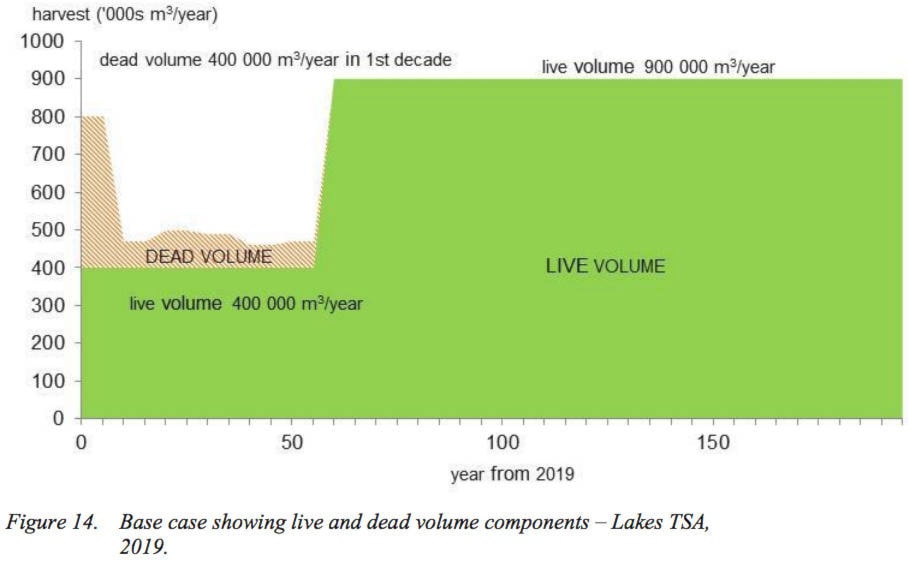Historical utilization of available timber shows that there is room for optimism despite the expected drop in the Annual Allowable Cut (AAC).
The provincial Ministry of Forests, Lands, Natural Resource Operations and Rural Development (FLNRORD) is currently accepting public input as it determines the new Lakes Timber Supply Area (TSA) AAC. Its level is now at 1.6 million cubic metres.
Many residents of the Burns Lake area are worried that a reduced AAC will affect forestry activities and cost jobs.
READ MORE: Prospect of lower lumber cut in the air
However, page 20 of the Lakes Timber Supply Area Timber Supply Analysis Discussion Paper shows the AAC levels compared to the actual harvest levels since 1999. For almost all of those years the amount harvested was lower - at times well below - the AAC.
The effect of a reduced AAC would have been greater if the forestry industry had been regularly using up all of its allotted timber.
That forestry pattern is not uncommon, as Phil Burton, Professor of Ecosystem Science and Management University of Northern British Columbia told Lakes District News.
There are various factors that explain why the industry wouldn’t use up all of the AAC, such as markets, remoteness and wood supply profile.
“Since the shutdown of several sawmills and two pulp mills in the northwest, much (if not most) of the AAC in the North Coast, Kalum, Cranberry and Cassiar TSAs has been under-utilized,” Burton said.
“The cost of logging and road building and long-distance hauling is often not worth the investment, especially when lumber prices are low, even though the wood is theoretically available to existing forest companies or new entrepreneurs.”
It’s unclear that forestry in the Lakes TSA could maintain its current activity with a lower AAC, even assuming that it is accustomed to under-utilization of the harvest limit.
However, Burton said a lower AAC could narrow the options for new operators or business expansion.
“If 5-10 million cubic metres…are being withdrawn from the estimated timber supply currently available from low- and mid-elevation forests because of fires, that could have a real impact on harvesting activities, even if there are another 25,000 hectares of forest available up high on the mountains or five hours away from the nearest mill.”
“Whether a company or new investor will go after the more expensive wood will depend on lumber prices,” he said.
From the perspective of FLNRORD, a big factor is the quality of the harvestable timber.
“In previous years, dead pine comprised more than 50 per cent of the harvest; and it’s not clear how much of the dead pine is still available for harvest,” said Ministry spokeswoman Dawn Makarowski.
“This may affect the overall final amount of economical fibre available in the timber supply area and other area-based tenures, such as community forest agreements and First Nations woodland licences.”
That model is illustrated on page 28 of the discussion paper, showing a drop of almost 50 per cent in the availability of dead volume over the next 30 years. Harvest availability of live timber is expected to remain at 400,000 cubic metres per year for the next 60 years, rising to 900,000 cubic metres after 70 years.
John Rustad, Nechako Lakes MLA commented on two scenarios of a future AAC.
In an optimistic scenario, where the AAC falls to 1 million cubic metres, just above the amount harvested in 2018, “it would be fine and I think industry could make it work. [But] of it is 350,000 [cubic metres] plus community forests, I’m worried that there may not be enough supply.”
Concerned residents will have to wait until the fall when the new AAC is unveiled, but Burton pointed out that there have been worries about timber supply in the past and regional companies found ways of keeping the industry operating.
“Many people thought there wasn’t even sufficient wood supply after the pine beetle (never mind recent fires) to rebuild the Babine mill” which was up and running again in 2014.
Blair McBride
Multimedia reporter
Send Blair an email
Like Lakes District News on Facebook
